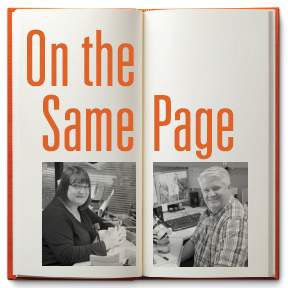
IMPROVING COMMUNICATION WITH YOUR DENTAL LAB.
Every human relationship depends upon open, honest communication in order to thrive. The relationships between dental labs and dentists are no different. In order to achieve the best results for your patients’ cases, an open line of communication with your dental lab is of the utmost importance.
Recently, the editors at Aesthetic Dentistry spoke with two technical support representatives at Arrowhead Dental Laboratory about ways that dental practices can best keep the lines of communication open. We spoke with Robert Shunn, a technical support representative in the Doctor Relations Department and Suzy Greenwood Fox, a technical support representative in the Implant Department. Shunn and Fox have a combined 17-plus years of experience with Arrowhead Dental Labs. Here’s a little of what these lab experts had to say.
AD: What are the characteristics of good communication between a dental practice and a lab?
RS: Empathy, respect and a willingness to work together to solve problems are extremely important in a lab/dentist relationship. This can sometimes be difficult to achieve in stressful situations, such as when a case doesn’t turn out the way a doctor envisioned. However, it’s important to remember that after the frustration and disappointment are over, we still have a problem to solve. So, why not work together? Lab technicians and dentists are on the same team. We are all working for the same goal—to create an amazing smile for the patients! Your success is our success.
SGF: The best type of communication (especially related to implant cases) comes from doctors who clearly communicate exactly what they want for each and every case. We want to do the best job for you and to achieve that, we need to have all the specifics about your cases. Over the years, I’ve learned one very crucial fact: a lab can never have too many details on a case. More details are definitely better than not enough.
AD: What can dentists start doing today to improve the quality of the communication with the lab?
RS: A simple start is for dentists to completely fill out the Rx—and make sure it’s detailed. Write in full, Standard English and not abbreviated, text-messaging language. Also, make sure the prescriptions are legible. When the lab is forced to guess, the chances of making a mistake dramatically increase. Lastly, I tell all the dentists I work with that if any kind of question or problem arises, don’t hesitate to pick up the phone and call me. The sooner the better! That way we can resolve any issues immediately.
SGF: When you package the cases to send us, make sure everything is properly labeled—this is especially important with implant cases. Tell us which size goes to which tooth number. If you have similar things in the box (like two blue transfers, for instance), then let us know what goes where. Proper packaging is something simple that greatly helps us on implant cases. It also ensures that we get everything we need. This small investment in time at the beginning of a case pays off in shorter production times for cases and decreases the possibility of problems.
AD: Are there common practices or processes that complicate communication? If so, what are they and how might they be improved?
RS: Yes. Often, dentists will assign the task of communicating with the lab to their assistants. We understand that dentists have very busy schedules, but keep in mind that if the assistants aren’t totally ‘up to speed’ on the cases, it can complicate communication with the lab. In these scenarios, a lot of phone calls usually go back and forth and crucial information can get lost along the way. If the dental lab is unsure about how to proceed, the case gets put on hold until we can get the issues resolved. On large or complicated cases it is generally much faster for dentists to speak to the lab directly.
SGF: I would add that if doctors would consider educating their front office on how to read basic chart information, it would be ex-tremely helpful. When we call an office, sometimes we need some very basic information and don’t want to bother the dentist. However, the person on the phone may not know how to read a chart and sometimes can’t read us the notes we need. The practices that have the best lab communication are ones in which a doctor has used an occasional staff meeting to teach staff members some of these basic skills.
AD: What are the most important pieces of information that a dental lab needs from a doctor in order to fabricate a dental restoration? How does that change as the complexity of the case increases?
RS: There are five important pieces of information for a case, which include: the material to be used, the shade, the stump shade, high-resolution photos and a quick explanation of the patient’s expectations. Also, consider filling us in on a patient’s likes and dislikes. Maybe one patient wants something ultra strong while another patient is an 18-year-old beauty queen, who is mostly concerned about aesthetics. It’s helpful to know what a patient likes about his or her current teeth, so that can be taken into consideration with the design of the crowns. As far as complexity and communication, remember, the bigger the case, the greater the amount of communication that is needed.
SGF: The five most critical points when it comes to implants are: material, size and system, any special design requests, any ‘red flags’ that we should know about and any details specific to the patient.
AD: What is the most common communication failure and how does that affect the production of a case?
RS: The most common communication error I see is in relation to bites. Often, we have no registrations, no stick bites and no photos of any kind. Other errors are bridges in the posterior that have been taken with quadrant trays instead of full arch trays. Therefore, the smile has been pieced together. With this latter example, our production is affected because we’ll sometimes get three or four units with two teeth to articulate to and we don’t know if the bite is over-closed or what is happening on the contralateral side. We don’t know how to design the teeth or how they’re functioning.
As an industry, we generally use the quadrant trays—mainly for convenience. If more full arch trays were used, we’d start with a much better impression. Digital impressions are also a better choice than the quadrant trays on large cases.
SGF: Poor communication may hinder the production of a case. If we run into questions about design or other related specs, we will definitely be delayed. Also, implant cases are not as straightforward as standard restorative cases. Because of that, additional communication is often needed. We need good impressions. We need a bite registration. We want to leave the guesswork out of every case. Whenever there is room to guess, there is room to err. Our goal is to ensure that your patients get the perfect outcome the first time and that dentists can maximize the production potential.
AD: When it comes to cases that need to be remade, are communication failures typically to blame?
RS: Most commonly, when a case needs to be remade, it generally stems from substandard impressions or inappropriate material selection. As a technical support technician, my sole purpose is to act as an advisor to the dentist. Today there are more materials and options than a busy dentist can be expected to fully understand. Remember, we do thousands of cases every year, so we are able to offer you a unique perspective when it comes to these common issues. The most successful cases come from dentists who take advantage of the lab’s expertise.
SGF: I agree with Robert. Almost all of the remake cases I see are because of impression errors. In addition, another remake error is because of bites being off. For implant cases, doctors tend to do quadrant impressions and triple trays. However, for any implant case, what I highly recommend is that the dentists do full arch impressions, single stack trays and a bite registration. By doing this, it significantly lowers the possibility of a case needing to be remade.
AD: What data is most often left off the Rx? How does an incomplete Rx affect the case?
RS: The two most common details left off the Rx are material and shade. Sometimes I get an Rx with nothing checked and other times I get an Rx where conflicting materials have been selected. This delays the case and everything is put on hold until we have the correct information. Putting things on hold creates issues for everyone (dentist, patient, and lab), so it’s best to keep the cases moving forward. The only way to achieve that is to make sure that the Rx is completed and that conflicting information is avoided.
SGF: Sometimes dentists will leave off the material, shade, and overall design specs from the Rx. If we don’t have this information, we cannot complete the case. As Robert said, it will be placed on hold and we’ll have to work on other cases until we can get the requisite information. Having the key information allows the case to immediately go into production and avoid the dreaded ‘hold shelf.’
AD: Given the vast array of materials on the market, what can a dentist communicate to the lab that will help make sure the appropriate materials are used? What if the dentist is unsure about the material requirements?
RS: Ask to be contacted once the case comes in and we can help you decide what types of materials will be best. Many different materials are available for all kinds of situations and we are happy to help you navigate through that process. Just remember, you can’t be expected to know about all of the various options—it’s our job as technical support to know this and help you make choices. Matching the right materials to the patient is one of the most important ways to ensure the longevity of the dental restorations. We don’t want a patient going back to the dentist because a new crown fails.
SGF: To help make sure the appropriate materials are used, include pertinent details about the patient. Is this patient a bruxer? Does this patient want the strongest material possible or is he or she wanting a specific aesthetic look? Dentists don’t have to know exactly which materials to choose. One of the key advantages of a lab is having a staff that is dedicated to helping the doctor design and plan the case. The more information we get at the outset, the faster and more accurate that case plan will be and the faster the case can be completed.
AD: With a remake case, what is the most important thing for a dentist to communicate to technical support in order to resolve a problem?
RS: First, call the lab ASAP. If a case has to be remade for any reason, time is of the essence. Please don’t send it back in the mail with a note that says, “remake.” If you call us immediately, we can figure out the problem and in some cases, the problem can be resolved immediately. With remakes, we want to avoid repeating the initial error, so if we are given details as to the original problem, we can make sure that it does not recur.
Second, check the crown on the model to see if what we sent mirrors what is in the mouth. This helps determine if it is an impression issue or a temporary issue. We need that information to remake the case.
Third, return EVERYTHING to us. We can sometimes fix things that you wouldn’t think possible! Also, we can often find the origin of the problem by looking at the old impression.
Fourth, fill out the comment card that is mailed with your cases. This is an important way of communicating that allows us to track things and make sure that we are producing your cases to your preferences.
Fifth, help us to help you! It’s easiest to solve problems as a team, so just remember that we’re on your side and want to help make this the best case it can be for your patient.
SGF: Remember that remake cases get priority. So the best way to get your case to the top of our workload is to give us a call. As Robert mentioned, call us before shipping everything back. It’s also very helpful if you send us a new impression. Many times, the main problem with the case is discrepancies in the old impression. In general, the biggest problem with remakes in implants can be linked to the impressions. Finally, please know that we understand and feel your frustration if something doesn’t turn out correctly. We will do whatever it takes to find a resolution.
AD: What is the most effective way for a dentist to help the lab optimize cases so that they are produced ac-cording to the dentist’s liking?
RS: In one word, FEEDBACK! Feedback is crucial to helping us improve the products that we make for you. Communication on one project isn’t just about getting that one project done—it’s also about letting us know your requirements for future cases. It’s helpful if doctors complete their preferences sheets with their doctor relations representative. Preference sheets help us to know your partialities when it comes to certain styles. Call the lab once a year and make sure everything is updated. Also, every time you give comments to tech support about various issues, we can add these details to your preference sheet as well.
SGF: Post-op communication is important to us. It’s very helpful to hear things like, “This case went beautifully! I want every case to be like this one!” When we get this type of feedback, we add it to the doctor’s preference sheet. Then we can see what worked well and know how to make the dentist happy in the future. If the feedback after a case is negative, we want to hear that, too. Everything helps us to improve the next time. Our goal with every case is to make a restoration that goes in without a problem so that every doctor gets a custom restoration made exactly how he or she wants it.
AD: Are there some simple rules from the lab perspective that, if dentists followed them, could reduce the number of case calls from the lab?
RS: Yes. If you want to reduce the amount of calls you get from the lab, make sure you complete the Rx and provide clear direction on what you want, especially if the case has special considerations or unusual requirements.
SGF: If you feel like you’re getting too many calls from the lab, chances are we feel like we’re making too many calls! This can be reduced by completing the Rx. Flag a case if it’s special and mark the reasons why. If we have the information to put it into produc-tion, then we should rarely have to call you.
AD: Is there anything else that dentists can do to help ensure effective communication?
SGF: Let us know your preferred method of communication. If you want us to email you, call you after hours on your cell phone, or text you, we’re happy to do that. If you want us to talk to your assistant, that’s fine, too; providing that your assistant understands the case.
As these experts have shown, fine-tuning communication between dentists and their labs helps promote greater service and efficiency with cases. Because of that, at Aesthetic Dentistry, we recommend that dentists make a commitment with their teams to take the steps necessary to improve this communication. Two easy things dental teams can do is remember to write or type prescriptions clearly and call immediately if they have any questions regarding materials or processes. A little extra time and effort will definitely pay off with results that everyone is happy with.
It certainly can be said that when dental teams and their labs are on the same page, each and every case will turn out to be one for the books!










